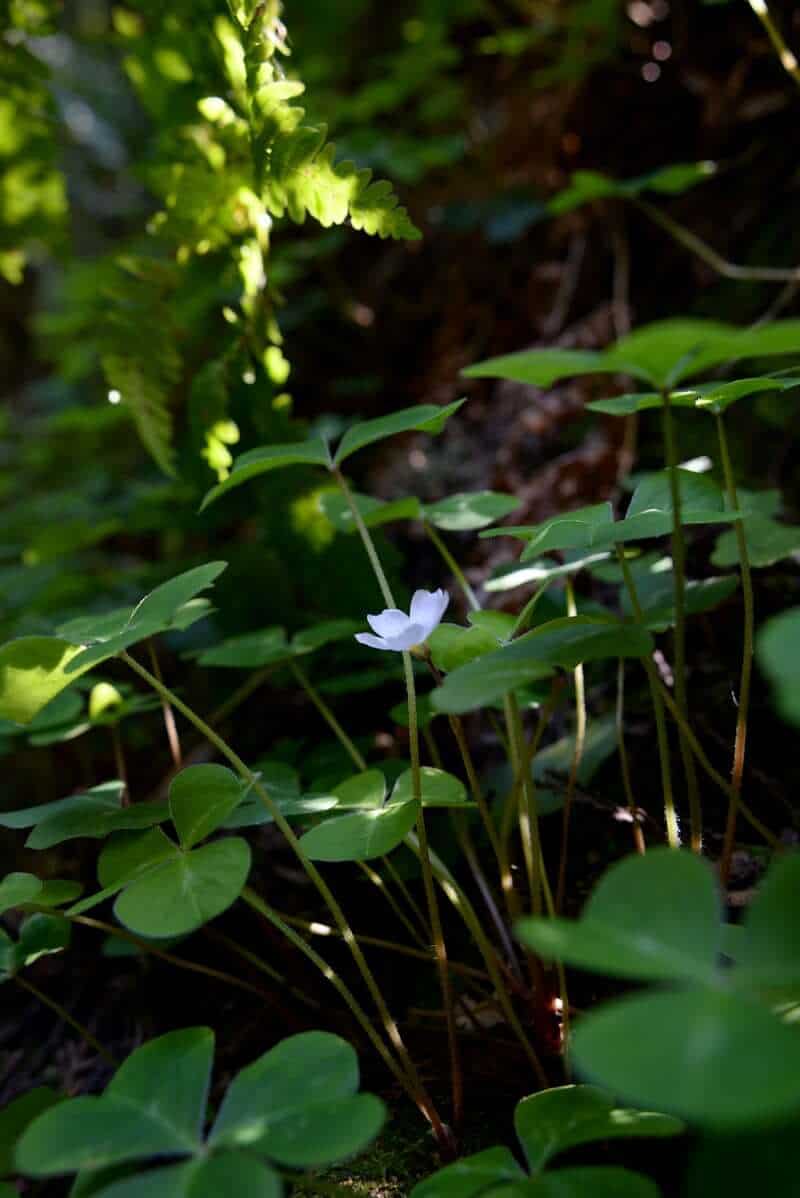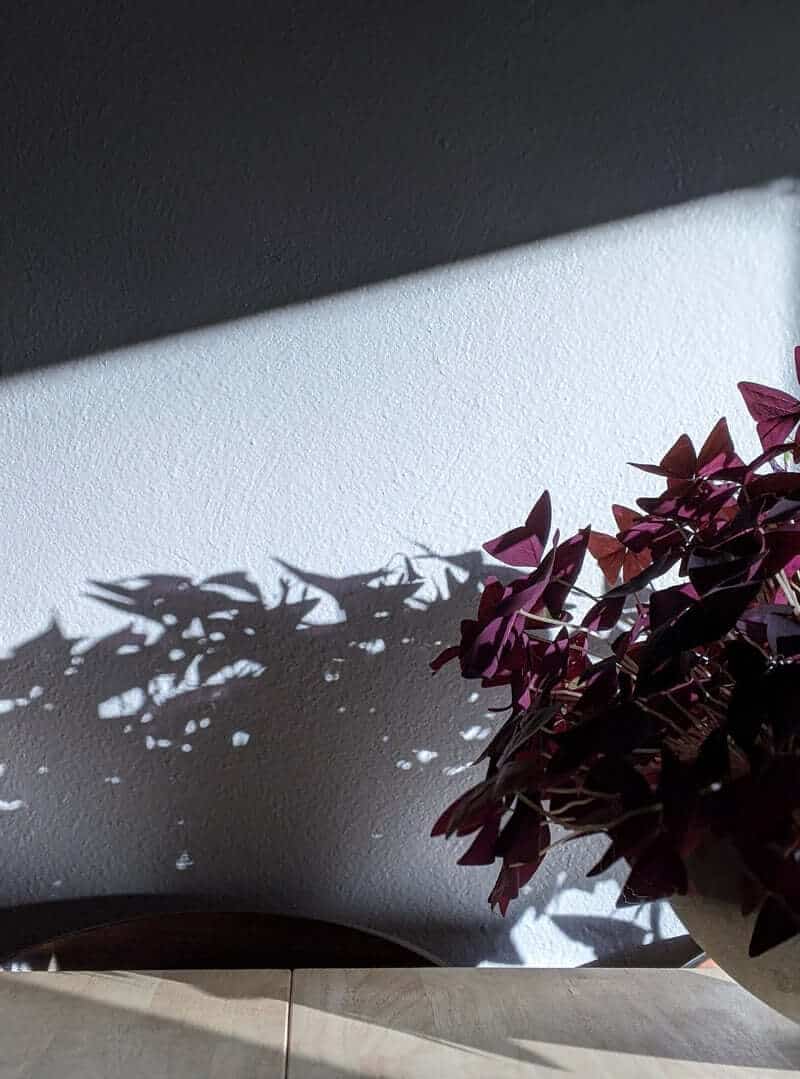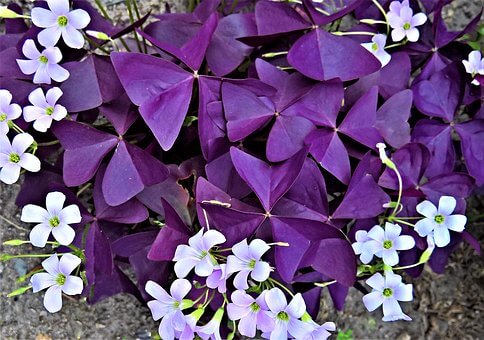Last Updated on January 9, 2023 by a Friendly Gardener
If you are Irish you undoubtedly know the symbolic importance of the Shamrock, and Mother Nature has provided the attractive Shamrock plant, an appealing houseplant that boasts lovely green foliage and lovely delicate flowers. Even if the shamrock is identified with the Irish, this delightful plant finds its native habitat in Brazil.
Botanically named the Oxalis regenellii, it is a member of the Oxalidaceae family. This smallish perennial plant practically never grows more than six inches making it ideal for decorating small spaces. Clover-shaped leaves in a variety of purple and green hues, and delicate white or pink autumn blooms distinguish the Shamrock plant. It is considered to be lucky for its owner.
The Shamrock is a nyctinastic plant as its leaves fold up with the arrival of sundown and reopen with the dawn. This is an easy plant to cultivate. An important aspect of successful cultivation is respecting its dormancy periods. Unlike many other plants, they will enter dormancy in the summer. When the foliage dies back, it needs darkness to rest, and watering should be reduced and fertilization suspended.
The Shamrock’s dormancy period can last from as little as several weeks to as much as three months. This will depend on the specific cultivar and the environmental growing conditions. When new growth shoots appear, you’ll know your plant has reawaken. Once the dormancy period has ended, move the Shamrock plant to a location with bright light.

Other Shamrock plant names include:
- Black oxalis
- False Shamrock
- Love plant
- Oxalis
- Purple Shamrock
- Shamrock
- Wood Sorrel
“False Shamrock” is used as a name because this plant has been sold as clover or as true shamrock (Trifolium spp.).The Trifolium is native to Ireland and belongs to the Wood Sorrel family. The two plants, both authentic and false, feature different root systems. Authentic clover is fibrous while the false shamrock grows from a bulb. Authentic clover is not adapted to indoor cultivation because it requires more daylight. True Shamrocks are also annuals. The False Shamrock is a perennial.
Shamrock Plant Care

In autumn, new shoots should appear, and you can resume watering. Keep the soil slightly moist during the growing season. Shamrocks can be watered about every ten days or three times monthly. This will permit the soil to dry out somewhat between waterings.
Cultivated from small bulbs, the Shamrock should be planted in autumn or at the beginning of spring. There are numerous cultivars so search for one that thrives as an indoor houseplant. Selecting one that grows outdoors will not necessarily do well as a houseplant.
The Shamrock’s foliage will die back during dormancy and the plant may appear as if dead. As soon as this process begins, reduce watering and cease feeding your plant. Wait for new growth before resuming normal care.
Soil
The Shamrock plant requires a well-draining soil bed. It thrives in various soil types. Ideally, the soil should be loamy or at least a bit sandy. Soggy soil can lead to root rot. A well-draining potting mixture is necessary for the general health of your plant.
To create an appropriate potting mix, mix one-third potting mix with one-third peat moss and one-third potting soil.
Light
The Shamrock will succeed in full direct sunlight as well as in partial shade. For outdoor cultivation, partial shade is a better choice. This will protect the plant from afternoon UV rays. If cultivating indoors, the Shamrock should be placed in a window with bright sunlight. Rotate your plant every several days to guarantee bright light to the entire plant. If your Shamrock does not receive adequate light, it will weaken. This plant grows leggy when searching for sunlight.
Water and Humidity
The soil bed needs to maintain moisture evenly. Mature Shamrock plants do tolerate limited drought and are forgiving if you forget to water on occasion.
When the Shamrock begins its growing season, it needs watering when the soil’s top inch becomes dry. During the dormancy period, water your plant every two to three weeks, so that the soil does not dry out entirely.
The Shamrock plant prefers moderate humidity, so normal home humidity levels should be sufficient for indoor cultivation.
Temperature
Shamrocks love temperatures that measure between 60° to 75° Fahrenheit making them ideal for indoor cultivation. Nighttime temps can reach as low as 50°F. Dormancy can be provoked if the temperatures rise above 80°F.
Shamrocks should be protected from drafts whether from windows, doors, hallways, heating sources, or air conditioning units. Drafts can harm the plant’s leaves.
Residents of mild climates can cultivate the Shamrock plant outdoors year-round and can employ it as a ground cover. In colder climates, bulbs should be dug up, removed, and stored till spring.
Feeding

You can feed your Shamrock plant during the growing season. Use a liquid fertilizer diluted to half-strength. You can also blend some compost into the soil bed. The Shamrock plant does not tolerate salt buildup well. Leaves can suffer burning. It’s recommended that you flush the soil periodically and at least once every four to six months. Place your Shamrock plant in a sink or tub under a faucet, run the water for approximately five minutes, and let the soil bed drain.
Pruning
Pinch off dead leaves. This should be done when your plant enters its dormancy period.
Repotting

Repot your Shamrock plant every year or two during the plant’s dormancy period. The actual container can be reused or select a new one that is one size larger. If the plant develops new offsets, remove them and reuse the same pot because the plant will maintain its actual size.
Shamrock Plant Propagation
Wait two weeks once the plant’s dormancy period has begun to propagate your plant. Remove the bulb from the garden or container soil bed. Gently remove the small offsets with bulbs. Individual bulb offsets can be replanted each in a separate container. Expect all-new plantlets to emerge and develop after the mother plant and at the dormancy period’s end.
Shamrock Toxicity
The ASPCA (American Society for the Prevention of Cruelty to Animals states that the Shamrock Plant is toxic for cats, dogs, horses, and humans. This is because these plants contain soluble calcium oxalates. The bulb is the most toxic part of the Shamrock plant, but it’s important to remember that all parts are toxic.
Should your pet ingest even a small portion of this plant, any one of the following poisoning symptoms may appear:
- vomiting
- tremors
- lethargy
- gastro-intestinal distress and pain
- excessive drooling or salivation
- diarrhea
Fortunately, the Shamrock plant is very bitter to the taste. This bitterness discourages pets from ingesting large quantities. The consummation of large quantities can cause kidney failure. If you suspect ingestion by pets or small children, contact your doctor, your veterinarian, or your local poison control center immediately.
Pests, Diseases, and Problems
While not at risk for serious disease, the Shamrock plant is susceptible to overwatering. Water-laden soil will lead to root rot when the plant is left standing in it. Bulbs turn mushy in texture and black. The plant then dies.
Shamrock plants can also contract fungal infections such as rust and powdery mildew. Fungal infections are more frequent in cooler temperatures, excessive humidity, and insufficient light.
Powdery mildew causes a white powdery patch somewhere on the plant. Rust instead causes small, yellow spots on plant foliage and a white film covering the entire plant. Sometimes you can contrast these infections by relocating the plant to a brighter place. You can also treat the plant with an organic fungicide like Neem oil.
Mealybugs and spider mites may visit your plant and take up residence. These pests should be treated with an organic insecticidal soap or with Neem oil.
A Final Thought
With a dark purple hue and characteristic appearance, this striking plant will adorn any home garden both indoors and outdoors. The Shamrock will brighten your home with delicate beauty and good fortune.


